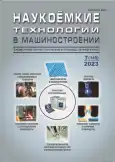INVESTIGATION OF FORM DEVIATIONS OF HIGH-SPEED STEEL (HSS) PRODUCTS UNDER TURNING-MILLING OPERATION USING AUTOMATICALLY PROGRAMMED TOOLS
- Authors: Matlygin G.V.1, Savilov A.V.2, Nikolaev A.Y.2, Timofeev S.A.1
-
Affiliations:
- Irkutsk State Technical University
- Issue: No 7 (145) (2023)
- Pages: 15-23
- Section: Technologies of mechanical processing of workpieces
- URL: https://bakhtiniada.ru/2223-4608/article/view/350090
- DOI: https://doi.org/10.30987/2223-4608-2023-7-15-23
- ID: 350090
Cite item
Full Text
Abstract
Investigation of form deviations of cylindrical high-speed steel (HSS) products made under turning-milling operation by CNC-controlled lathe machining center (further CNC) with auxiliary drive axle is given. Technological support of high-speed steel products quality made by turning milling operation on a CNC lathe machining center with an auxiliary drive axle takes effect owing to the shape deviation reduction. Planning of experiments was carried out according to the Taguchi method for four factors and three levels. The experiment was conducted on a DMG NEF 400 lathe machining center having an auxiliary drive axle, which allows machining modes to be performed with a rotating tool. Samples of high-speed steel R6M5K5-MP were used. Machining operation was made according to the scheme of orthogonal turning by milling. A core carbide mill CCM 4321 was used as a cutting tool. Out-of-roundness (lobing) was estimated using optical method. All measurements were carried out on the Bruker Contour GT-K1 optical profilometer. Surface micro-dimensions were measured by optical scanning of the surface. Surface optical scanning resulted in a point cloud was obtained that mirrors micro-dimensions of the cylindrical profile of the piece partmeasured section. The obtained data obtained made it possible to measure a lobing that occurs under orthogonal milling turning method. The influence of cutting modes on the shape and size of the maximum peaks of the cut is proved. The smallest facet pattern value is observed for milling width a_e in the range of 3,5...5,5 mm with high feed values for the tooth f_z and low cutting speed v_c. The largest cut height is observed at the average values of a_e, a_p, v_c. It is an optical profilometer that is an effective means of measuring facet patterns or lobings. The results obtained in the work allow predicting form deviations of a blank made of high-speed steel under turning milling operations on CNC machines. The results of the study can be used to improve rotary cutting tools quality in the tool industry.
About the authors
Georgiy Valer'evich Matlygin
Email: gmatlygin@mail.ru
ORCID iD: 0000-0002-5484-6250
Scopus Author ID: 59736842695
ResearcherId: AFF-6791-2022
1
Andrey Vladislavovich Savilov
Irkutsk State Technical University
Email: saw@istu.edu
candidate of technical sciences
Andrey Yur'evich Nikolaev
Irkutsk State Technical University
Email: andrnikolajev@gmail.com
Sergey Anatol'evich Timofeev
Author for correspondence.
Email: andrnikolajev@gmail.com
References
Захаров А.Д., Родин П.Р., Татаренко В.Н. Обработка фасонных поверхностей охватывающим фрезерованием // Резание и инструмент.1984. № 3. С. 7-11. Neagu C. Studiul geometriei funct ̧ionale a sculei la prelucrarea arborilor netezi prin frezare frontal ̆a // Study of Tool’s Functional Geometry in Machining Straight Shafts by Face Milling, The 5th Conference on Friction, Lubrication and Wear, Bucharest, 1987. Schulz H. High Speed Turn Milling A New Preci-sion Manufacturing Technology for the Machining of Ro-tationally Symmetrical Workpieces // CIRP Ann Manuf Technol, 1990, vol. 39, P. 107-109. doi: 10.1016/S0007-8506(07)61013-0. Savas V, Ozay C. Analysis of the surface rough-ness of tangential turn-milling for machining with end mill-ing cutter // J Mater Process Technol 2007. vol. 186. P. 279-283. doi: 10.1016/j.jmatprotec.2006.09.040. EDN: KLVMLT Choudhury SK, Bajpai JB. Investigation in or-thogonal turn-milling towards better surface finish // Jour-nal of Materials Processing Techn. 2005. vol. 170:3. P. 487-493. doi: 10.1016/j.jmatprotec.2004.12.010. Armarego E.J.A., Karri V., Smith J.R. Funda-mental studies of driven and self-propelled rotary tool cut-ting processes-I. theoretical investigation // Int. J. Mach. Tools Manuf. 1994. vol. 34 (6) P. 785-801. doi: 10.1016/0890-6955(94)90059-0. Солянкин Д.Ю., Ямников А.С., Ямникова О.А. Методика расчета сил резания при фрезоточении // Известия ТулГУ. Технические науки. 2011. № 3. С. 287-292. EDN: PVJTNH Zhibing L, Xibin W. Characteristic of surface profile and roughness in micro turn-milling of aluminum alloy 2A12 // Technology and Innovation Conference (ITIC 2009), International. 2009. P. 1-4. doi: 10.1049/cp.2009.1424. Rafai N.H., Islam M.N. An Investıgatıon into Dımensıonal Accuracy and Surface Fınısh Achıevable in Dry Turning // Machining Science and Technology. 2009. vol. 13 (4). P. 571-589. Karagüzel U., Uysal E., Budak E., Bakkal M. Analytical modeling of turn-milling process geometry, kin-ematics and mechanics // International Journal of Machine Tools and Manufacture. 2015. vol. 91. P. 24-33. Муцянко В.И. Бесцентровое шлифование. Л.: Машиностроение, 1967. 116 с. Comak A. Mechanics, dynamics and stability of turn-milling operations (T). University of British Columbia. 2018. doi: 10.14288/1.0368954. Ozay C., Savas V. The Optimization of Cutting Parameters for Surface Roughness in Tangential Turnmill-ing using Taguchi Method // Advances in Natural and Ap-plied Sciences. 2012. vol. 6. P. 866-874. Yildiz T., Gür A.K. The Optimization of Abra-sive Wear Behavior of Fecrc Coating Composite with Taguchi Method // Australian Journal of Basic and Applied Sciences. 2011. vol. 5 (12). P. 2394-2402. Матлыгин Г.В., Савилов А.В., Пятых А.С., Ушаков В.А. Технологические аспекты применения точения фрезерованием при изготовлении режущих инструментов // Вестник современных технологий. 2022. № 1 (25). С.16-22. EDN: MKLAXY
Supplementary files









